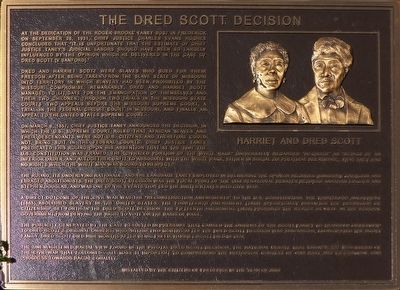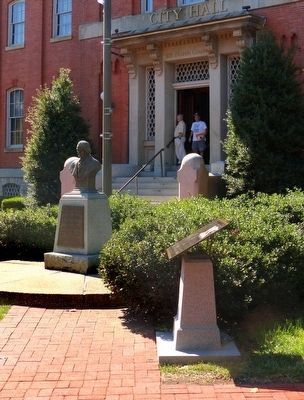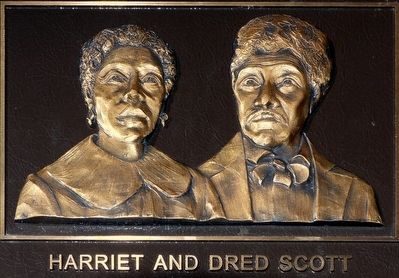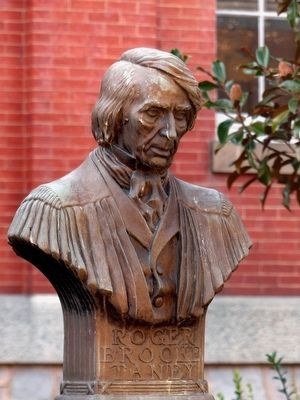Frederick in Frederick County, Maryland — The American Northeast (Mid-Atlantic)
The Dred Scott Decision
Dred and Harriet Scott were slaves who sued for their freedom after being taken from the slave state of Missouri into territory in which slavery had been prohibited by the Missouri Compromise. Remarkably, Dred and Harriet Scott managed to litigate for the emancipation of themselves and their two children, through two trials in the Missouri state courts, two appeals before the Missouri Supreme Court, a trial in the Federal Circuit Court in Missouri, and finally an appeal to the United States Supreme Court.
On March 6, 1857, Chief Justice Taney announced the decision, in which the U.S. Supreme Court ruled that African slaves and their descendants were not U.S. citizens and therefore could not bring suit in the Federal Courts. Chief Justice Taney predicated this ruling upon his assertion that at the time the U.S. Constitution was framed, the “civilized portion of the white race” universally regarded “negroes” as “beings of an inferior order, and altogether unfit to associate with the white race, either in social or political relations; …that they had no rights which the white man was bound to respect.”
One year later (1858), President Lincoln gave his famous speech entitled “House Divided” in which he argued that the Dred Scott decision was the product of a concerted effort by pro-slavery forces including Chief Justice Taney and President Buchanan to establish the legal underpinnings of a Union in which the right to own slaves would be guaranteed in all of the States and territories. This truly set the stage for the Civil War.
A direct outcome of the Civil War was the “Reconstruction Amendments” to the U.S. Constitution. The Thirteenth Amendment (1865) abolished slavery in the United States. The Fourteenth Amendment (1868) specifically nullified the definition of citizenship set forth in the Dred Scott decision. The Fifteenth Amendment (1870) prohibits the States as well as the Federal government from denying the right to vote on the basis of race.
The publicity generated by the case resulted in pressure that caused the owners of the Scott family to transfer ownership to Dred Scott’s original owners, who then (two months after the Dred Scott decision was announced) emancipated the Scott family. Dred Scott died nine months after being emancipated.
Harriet Scott died in 1876.
The unenlightened racial view found in the pivotal Dred Scott Decision, the national debate that ensued, the bloodshed of the Civil War that followed — all make it important to comprehend the historical context of our past and to continue our progress towards racial equality.
Installed by the citizens of Frederick in the year 2009
Erected 2009 by the citizens of Frederick.
Topics and series. This historical marker is listed in these topic lists: Abolition & Underground RR • African Americans • Government & Politics • War, US Civil. In addition, it is included in the Former U.S. Presidents: #15 James Buchanan, and the Former U.S. Presidents: #16 Abraham Lincoln series lists. A significant historical date for this entry is March 6, 1857.
Location. Marker is missing. It was located near 39° 24.948′ N, 77° 24.747′ W. Marker was in Frederick, Maryland, in Frederick County. Marker could be reached from the intersection of North Court Street and West Church Street, on the right when traveling south. Touch for map. Marker was at or near this postal address: 100 Court Street, Frederick MD 21701, United States of America. Touch for directions.
Other nearby markers. At least 8 other markers are within walking distance of this location. City Hall (a few steps from this marker); Unanimous Resolution (within
shouting distance of this marker); No to the Stamp! (within shouting distance of this marker); The Ross Home (within shouting distance of this marker); Ross House (within shouting distance of this marker); “South Magnetic” (within shouting distance of this marker); Frederick’s Poet Lawyer (within shouting distance of this marker); Birthplace of William Tyler Page (within shouting distance of this marker). Touch for a list and map of all markers in Frederick.
More about this marker. This historical marker was originally erected on the front lawn of the Fredrick City Hall next to a bust of Chief Justice Roger Brooke Taney. They were both moved to Mt. Olivet Cemetery in 2017 by order of the Frederick Board of Aldermen. The Taney bust is on display in the cemetery but this marker does not appear to have been placed on public display. The location given on this page is its original location.
Related marker. Click here for another marker that is related to this marker. It is the bust of Chief Justice Roger Brooke Taney that was also once at the county courthouse.
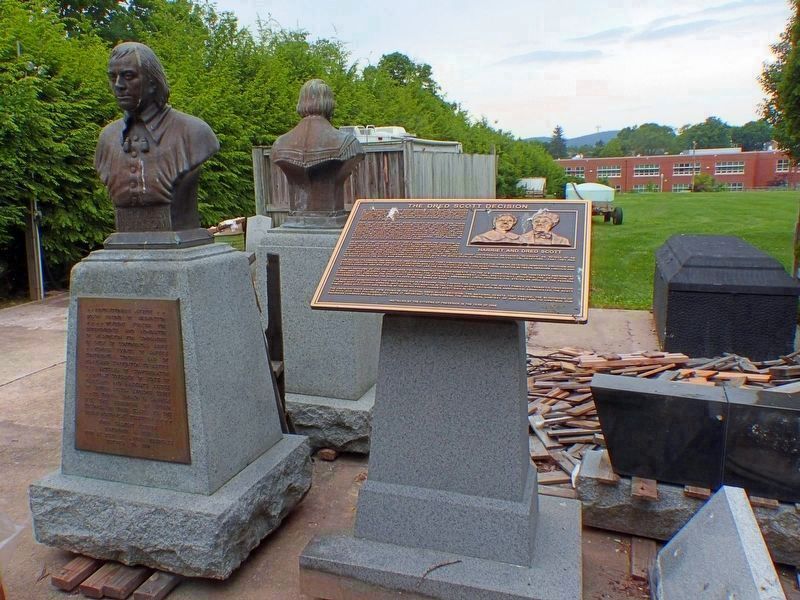
Photographed By Allen C. Browne, May 23, 2017
5. The Dred Scott Decision Marker at Mt. Olivet Cemetery
This marker, along with Urner's busts of Roger B. Taney and Thomas Johnson, were removed from the Frederick County Courthouse on March 18, 2017 and moved to Mt. Olivet Cemetery to be refurbished and eventually placed in the cemetery.
Credits. This page was last revised on March 2, 2020. It was originally submitted on September 26, 2015, by Allen C. Browne of Silver Spring, Maryland. This page has been viewed 825 times since then and 44 times this year. Last updated on May 28, 2017, by Allen C. Browne of Silver Spring, Maryland. It was the Marker of the Week March 1, 2020. Photos: 1, 2, 3, 4. submitted on September 26, 2015, by Allen C. Browne of Silver Spring, Maryland. 5. submitted on May 28, 2017, by Allen C. Browne of Silver Spring, Maryland. • Bill Pfingsten was the editor who published this page.
